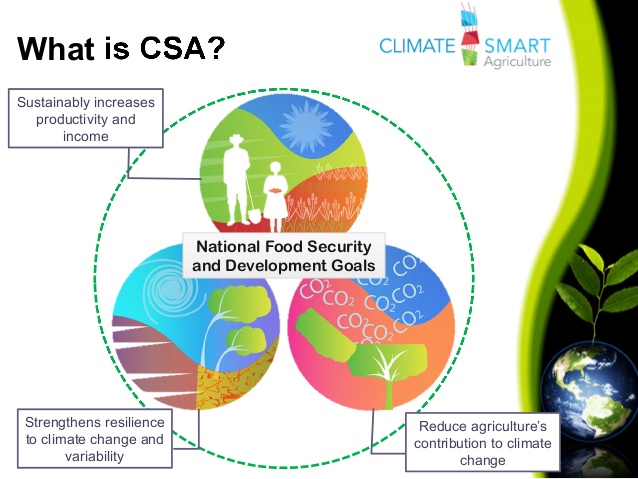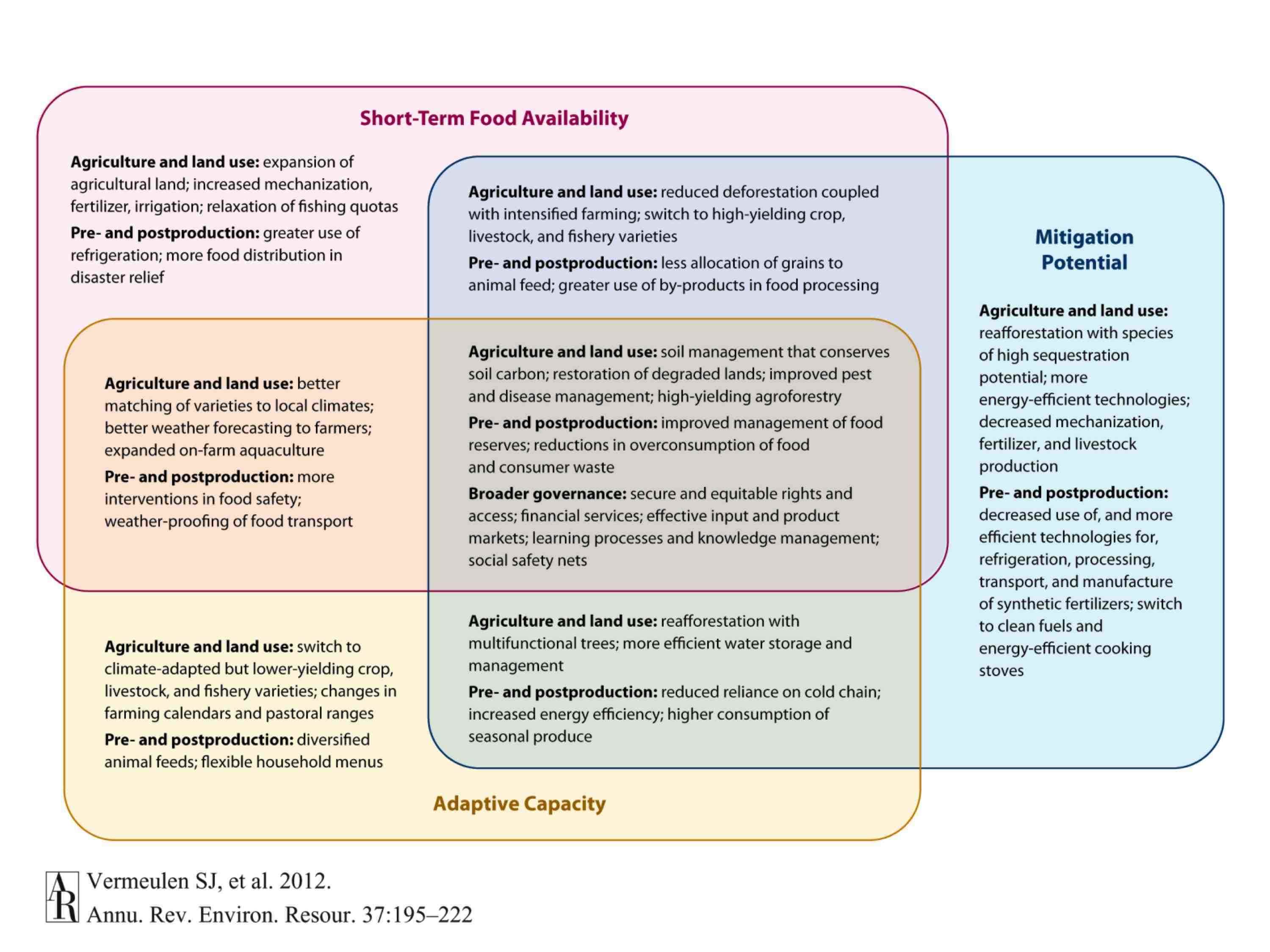What is CSA?
Introduction
Climate-smart agriculture (CSA) may be defined as an approach for transforming and reorienting agricultural development under the new realities of climate change (Lipper et al. 2014). 1 The most commonly used definition is provided by the Food and Agricultural Organisation of the United Nations (FAO), which defines CSA as “agriculture that sustainably increases productivity, enhances resilience (adaptation), reduces/removes GHGs (mitigation) where possible, and enhances achievement of national food security and development goals”. In this definition, the principal goal of CSA is identified as food security and development (FAO 2013a; 2 Lipper et al. 2014 1); while productivity, adaptation, and mitigation are identified as the three interlinked pillars necessary for achieving this goal.

Source: Presentation by Irina Papuso and Jimly Faraby, Seminar on Climate Change and Risk Management, May 6, 2013. 3
The three pillars of CSA
- Productivity: CSA aims to sustainably increase agricultural productivity and incomes from crops, livestock and fish, without having a negative impact on the environment. This, in turn, will raise food and nutritional security. A key concept related to raising productivity is sustainable intensification
- Adaptation: CSA aims to reduce the exposure of farmers to short-term risks, while also strengthening their resilience by building their capacity to adapt and prosper in the face of shocks and longer-term stresses. Particular attention is given to protecting the ecosystem services which ecosystems provide to farmers and others. These services are essential for maintaining productivity and our ability to adapt to climate changes.
- Mitigation: Wherever and whenever possible, CSA should help to reduce and/or remove greenhouse gas (GHG) emissions. This implies that we reduce emissions for each calorie or kilo of food, fibre and fuel that we produce. That we avoid deforestation from agriculture. And that we manage soils and trees in ways that maximizes their potential to acts as carbon sinks and absorb CO2 from the atmosphere.
Key characteristics of CSA
- CSA addresses climate change: Contrary to conventional agricultural development, CSA systematically integrates climate change into the planning and development of sustainable agricultural systems (Lipper et al. 2014). 1
- CSA integrates multiple goals and manages trade-offs: Ideally, CSA produces triple-win outcomes: increased productivity, enhanced resilience and reduced emissions. But often it is not possible to achieve all three. Frequently, when it comes time to implement CSA, trade-offs must be made. This requires us to identify synergies and weigh the costs and benefits of different options based on stakeholder objectives identified through participatory approaches (see figure 1).

Figure 1: Synergies and trade-offs for adaptation, mitigation and food security (Source; Vermeulen et al. 2012, p. C-3) 4
Key characteristics of CSA (contd.)
- CSA maintains ecosystems services: Ecosystems provide farmers with essential services, including clean air, water, food and materials. It is imperative that CSA interventions do not contribute to their degradation. Thus, CSA adopts a landscape approach that builds upon the principles of sustainable agriculture but goes beyond the narrow sectoral approaches that result in uncoordinated and competing land uses, to integrated planning and management (FAO 2012b; 5 FAO 2013a 2).
- CSA has multiple entry points at different levels: CSA should not be perceived as a set of practices and technologies. It has multiple entry points, ranging from the development of technologies and practices to the elaboration of climate change models and scenarios, information technologies, insurance schemes, value chains and the strengthening of institutional and political enabling environments. As such, it goes beyond single technologies at the farm level and includes the integration of multiple interventions at the food system, landscape, value chain or policy level.
- CSA is context specific: What is climate-smart in one-place may not be climate-smart in another, and no interventions are climate-smart everywhere or every time. Interventions must take into account how different elements interact at the landscape level, within or among ecosystems and as a part of different institutional arrangements and political realities. The fact that CSA often strives to reach multiple objectives at the system level makes it particularly difficult to transfer experiences from one context to another.
- CSA engages women and marginalised groups:To achieve food security goals and enhance resilience, CSA approaches must involve the poorest and most vulnerable groups. These groups often live on marginal lands which are most vulnerable to climate events like drought and floods. They are, thus, most likely to be affected by climate change. Gender is another central aspect of CSA. Women typically have less access and legal right to the land which they farm, or to other productive and economic resources which could help build their adaptive capacity to cope with events like droughts and floods (Huyer et al. 2015). 6 CSA strives to involve all local, regional and national stakeholders in decision-making. Only by doing so, is it possible to identify the most appropriate interventions and form the partnerships and alliances needed to enable sustainable development.
View case studies of CSA interventions
Examples of specific CSA interventions include soil management, drought-tolerant maize, dairy development, farming catfish intensively, carbon finance to restore crop fields, waste-reducing rice thresher, rainfall forecasts and incentive system for low-carbon agriculture.
References
-
1
Lipper L, Thornton P, Campbell BM, (…), Torquebiau EF. 2014. Climate-smart agriculture for food security. Nature Climate Change 4:1068-1072.
http://dx.doi.org/10.1038/nclimate2437 Climate-smart agriculture (CSA) is an approach for transforming and reorienting agricultural systems to support food security under the new realities of climate change. Widespread changes in rainfall and temperature patterns threaten agricultural production and increase the vulnerability of people dependent on agriculture for their livelihoods, which includes most of the world's poor. Climate change disrupts food markets, posing population-wide risks to food supply. Threats can be reduced by increasing the adaptive capacity of farmers as well as increasing resilience and resource use efficiency in agricultural production systems. CSA promotes coordinated actions by farmers, researchers, private sector, civil society and policymakers towards climate-resilient pathways through four main action areas: (1) building evidence; (2) increasing local institutional effectiveness; (3) fostering coherence between climate and agricultural policies; and (4) linking climate and agricultural financing. CSA differs from 'business-as-usual' approaches by emphasizing the capacity to implement flexible, context-specific solutions, supported by innovative policy and financing actions. -
2
FAO. 2013a. Climate-Smart Agriculture: Sourcebook. Rome, Italy: Food and Agriculture Organization of the United Nations.
http://www.fao.org/3/a-i3325e.pdf Between now and 2050, the world’s population will increase by one-third. Most of these additional 2 billion people will live in developing countries. At the same time, more people will be living in cities. If current income and consumption growth trends continue, FAO estimates that agricultural production will have to increase by 60 percent by 2050 to satisfy the expected demands for food and feed. Agriculture must therefore transform itself if it is to feed a growing global population and provide the basis for economic growth and poverty reduction. Climate change will make this task more difficult under a business-as-usual scenario, due to adverse impacts on agriculture, requiring spiralling adaptation and related costs. -
3
Papuso I, Faraby JA. 2013. Climate Smart Agriculture. Seminar on Climate Change and Risk Management, May 6, 2013.
http://www.slideshare.net/jimalfaraby/climate-smart-agriculture-20675751 This resource is comprised of slides from a presentation giving an overview of the climate-smart agriculture concept. -
4
Vermeulen SJ, Campbell BM, Ingram SJI. 2012. Climate Change and Food Systems. Annual Review of Environment and Resources 37:195-222.
http://dx.doi.org/10.1146/annurev-environ-020411-130608 Food systems contribute 19%–29% of global anthropogenic greenhouse gas (GHG) emissions, releasing 9,800–16,900 megatonnes of carbon dioxide equivalent (MtCO2e) in 2008. Agricultural production, including indirect emissions associated with land-cover change, contributes 80%–86% of total food system emissions, with significant regional variation. The impacts of global climate change on food systems are expected to be widespread, complex, geographically and temporally variable, and profoundly influenced by socioeconomic conditions. Historical statistical studies and integrated assessment models provide evidence that climate change will affect agricultural yields and earnings, food prices, reliability of delivery, food quality, and, notably, food safety. Low-income producers and consumers of food will be more vulnerable to climate change owing to their comparatively limited ability to invest in adaptive institutions and technologies under increasing climatic risks. Some synergies among food security, adaptation, and mitigation are feasible. But promising interventions, such as agricultural intensification or reductions in waste, will require careful management to distribute costs and benefits effectively. -
5
FAO. 2012b. Mainstreaming climate-smart agriculture into a broader landscape approach. Rome, Italy: Food and Agriculture Organization of the United Nations.
http://www.fao.org/docrep/016/ap402e/ap402e.pdf Today’s large diversity of semi-natural and manmade landscapes is the result of centuries of human interventions. The management and use of natural resources and ecosystem services have provided for humanity’s multiple needs for food, fibre, fodder, fuel, building materials, medicinal products and water. However, this has often been undertaken in an unsustainable manner causing the degradation of the natural resource base and loss of ecosystem services. Increasing pressure from population growth, changes in food consumption patterns, climate change and competition from other sectors is further weakening the viability of current systems. The triple challenges to simultaneously mitigate the effects of climate change, safeguard natural resources more efficiently and produce more food and ensure food security for future generations require effective policies and approaches. This paper examines how landscape approaches can be used in developing integrated multipurpose production systems that are environmentally and socially sustainable. The paper assesses the key policy, governance, financial and institutional interventions required, and looks at how a landscape approach can support the adoption of climate-smart agriculture and generate green growth. Finally, the paper considers how synergies between the agriculture and forestry sectors can be improved and how this can be facilitated through REDD+ implementation. -
6
Huyer S, Twyman J, Koningstein M, Ashby J, Vermeulen SJ. 2015. Supporting women farmers in a changing climate: five policy lessons. Policy Brief 10. Copenhagen, Denamrk: Reseach Program on Climate Change, Agriculture and Food Security (CCAFS).
https://cgspace.cgiar.org/rest/bitstreams/60479/retrieveRecent research presented at a seminar in Paris co-organized by the CGIAR Research Program on Climate Change, Agriculture and Food Security (CCAFS), the International Social Science Council (ISSC) and Future Earth produced five key policy recommendations for supporting women farmers in a changing climate: Key recommendations ` New technologies and practices for climate change will be adopted more successfully when they are appropriate to women’s interests, resources and demands; ` Extension and climate information services need to serve women and men; ` Institutions need to take into account women’s priorities and support their adaptive capacity; ` Women’s capacity as farmers and innovators needs to be recognized and supported; and ` Climate policy processes should go beyond numerical representation of women to create active mechanisms to express opinions, take initiatives, and influence decisions.